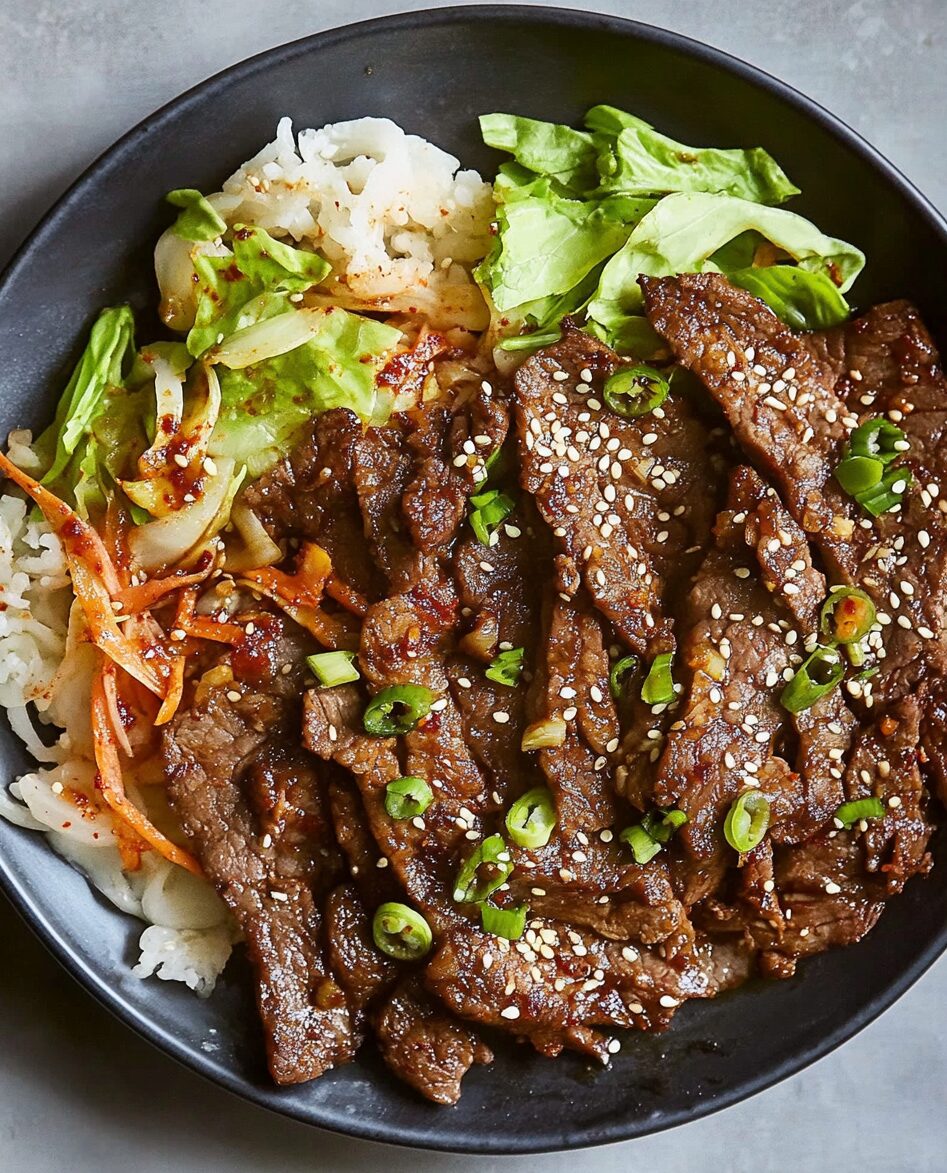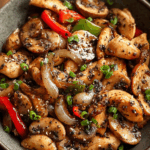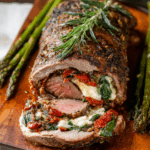Beef Bulgogi is a popular Korean dish known for its rich, savory flavors and tender, marinated beef. The marinade, a perfect balance of soy sauce, sugar, garlic, and sesame oil, elevates the thin slices of beef to create a deliciously caramelized exterior when grilled or pan-fried.
This dish is versatile and can be served in various ways—over a bed of steaming rice, wrapped in fresh lettuce leaves, or alongside traditional Korean sides like kimchi. Whether you’re looking for a quick weeknight dinner or a flavorful addition to your next BBQ, Beef Bulgogi is sure to impress!
Full Recipe
Ingredients:
- 1 pound beef sirloin, thinly sliced
- 1/4 cup soy sauce
- 2 tablespoons sugar
- 1 tablespoon sesame oil
- 2 cloves garlic, minced
- 1 tablespoon rice wine (mirin)
- 1/2 teaspoon ground black pepper
- 1 small onion, thinly sliced
- 2 green onions, chopped
- 1 tablespoon sesame seeds
- 1 teaspoon vegetable oil
Directions:
- In a large bowl, combine soy sauce, sugar, sesame oil, garlic, rice wine, and black pepper. Stir until sugar is dissolved.
- Add the thinly sliced beef, onion, and green onions to the marinade. Toss to coat, cover, and refrigerate for at least 30 minutes or up to 2 hours for maximum flavor.
- Heat a grill or large skillet over medium-high heat and add vegetable oil.
- Grill or stir-fry the beef for 2-3 minutes per side until it is cooked through and slightly caramelized.
- Garnish with sesame seeds and serve hot with steamed rice, lettuce wraps, or kimchi.
Prep Time: 15 minutes | Marinate Time: 30 minutes | Cooking Time: 10 minutes | Total Time: 55 minutes
Kcal: 320 kcal | Servings: 4 servings
History and Origin of Beef Bulgogi:
Beef Bulgogi is a classic dish from Korean cuisine, believed to date back to the Goguryeo period (37 BCE–668 CE). The name “Bulgogi” translates to “fire meat,” referring to its traditional cooking method of grilling marinated beef over an open flame. Initially, it was a dish reserved for the Korean royal family and the elite, but over time, it became a staple enjoyed by all Koreans, particularly during celebratory events and family gatherings.
Key Ingredients and Flavor Profile:
The core components of Beef Bulgogi include thin slices of beef (usually sirloin or ribeye) marinated in a mixture of soy sauce, sesame oil, garlic, sugar, and other seasonings. The marinade balances sweet, salty, and umami flavors while enhancing the tenderness of the meat. Garlic and onions add depth to the dish, while sesame seeds bring a nutty aroma and texture.
The cooking process, whether grilled or stir-fried, creates caramelized edges that make each bite packed with flavor. Pairing it with rice, lettuce wraps, or pickled vegetables like kimchi brings out a refreshing contrast, making it a complete meal.
Variations of Bulgogi:
While beef is the most common type of bulgogi, you can find variations that use pork (Dwaeji Bulgogi), chicken (Dak Bulgogi), or even tofu for a vegetarian twist. In some regions, the marinade may include grated pear or apple, which helps tenderize the meat while adding a subtle sweetness to the dish.
Serving Suggestions:
- Rice: The most traditional way to serve Beef Bulgogi is over steamed white rice. The rice soaks up the flavorful juices from the meat, making it an integral part of the meal.
- Lettuce Wraps (Ssambap): A fun and healthy way to enjoy Bulgogi is to serve it with fresh lettuce or perilla leaves. Add a scoop of rice, a piece of Bulgogi, a bit of ssamjang (fermented soybean paste), and perhaps a slice of garlic or kimchi for a flavor explosion in every bite.
- Side Dishes: Serve Bulgogi with a variety of banchan (small Korean side dishes) such as kimchi, pickled radishes, seasoned spinach (Sigeumchi Namul), and spicy cucumber salad (Oi Muchim). These sides provide freshness and balance the rich flavors of the beef.
Cooking Tips:
- Meat Slicing: For the best results, use partially frozen beef when slicing it thin. Freezing the beef for about 30 minutes makes it easier to slice thinly, which helps the meat absorb the marinade more effectively.
- Marinade Time: While marinating for 30 minutes gives good results, letting the beef sit for 2 hours or even overnight in the refrigerator will intensify the flavors.
- High Heat Cooking: Whether grilling or stir-frying, cooking over high heat ensures that the beef gets a quick sear, locking in the juices and creating a crispy, caramelized exterior.
- Serve Immediately: Bulgogi is best served hot and fresh off the grill or pan to fully enjoy its juicy, savory flavors.
Nutritional Benefits:
Beef Bulgogi, while indulgent in flavor, can be a nutritious part of a balanced meal. The thinly sliced beef provides a rich source of protein, essential for muscle repair and energy. Sirloin or ribeye, commonly used for this dish, are relatively lean cuts of beef, especially when trimmed of excess fat.
- Protein: The high protein content supports muscle growth, repair, and overall body maintenance.
- Vitamins and Minerals: Beef is an excellent source of B vitamins (B12, B6, niacin), which aid in energy metabolism and red blood cell formation. The iron in beef is essential for oxygen transport in the blood, and zinc contributes to immune function and DNA synthesis.
- Healthy Fats: Sesame oil, a key component in the marinade, contains heart-healthy fats and antioxidants that may help reduce inflammation.
- Low-Carb Option: When served with lettuce wraps instead of rice, Bulgogi can become a low-carb, high-protein dish, suitable for those following ketogenic or low-carb diets.
Modern Takes on Bulgogi:
In recent years, Bulgogi has evolved beyond its traditional roots. It has become a popular addition to fusion cuisine, featured in dishes like:
- Bulgogi Tacos: A popular street food twist, pairing tender Bulgogi beef with soft corn tortillas, topped with kimchi slaw, cilantro, and a spicy gochujang (Korean chili paste) sauce.
- Bulgogi Bowls: A healthier, grain-based version where Bulgogi is served over quinoa or brown rice, alongside roasted vegetables and a drizzle of sesame dressing.
- Bulgogi Burgers: Inspired by the traditional flavors, Bulgogi beef is sometimes transformed into burger patties, seasoned with a similar marinade and topped with Asian slaw or pickled cucumbers.
Cultural Significance:
Bulgogi is more than just a meal in Korean culture—it’s often part of larger gatherings, holidays, and celebrations. In South Korea, family meals centered around Bulgogi bring people together, symbolizing warmth and unity. When served at festive events, it’s often accompanied by other Korean staples such as Japchae (sweet potato noodles), Galbi (short ribs), and various types of kimchi. Bulgogi’s versatile, flavorful nature has made it one of Korea’s most beloved and internationally recognized dishes.
Ingredient Alternatives:
For readers who may not have access to specific ingredients, here are some alternatives:
- Beef Cuts: If sirloin or ribeye aren’t available, flank steak or brisket can be used as they also work well with the marinade and high-heat cooking method.
- Soy Sauce Alternatives: For those who need a gluten-free version, tamari or coconut aminos can be substituted for regular soy sauce.
- Sweeteners: While sugar is a traditional part of the marinade, honey, brown sugar, or agave syrup can be used as alternatives for a more complex or healthier sweetness.
- Marinating with Fruit: Adding grated Asian pear or apple to the marinade is a classic trick in Korean cooking. This not only adds natural sweetness but also acts as a tenderizer, ensuring the beef is soft and flavorful.






